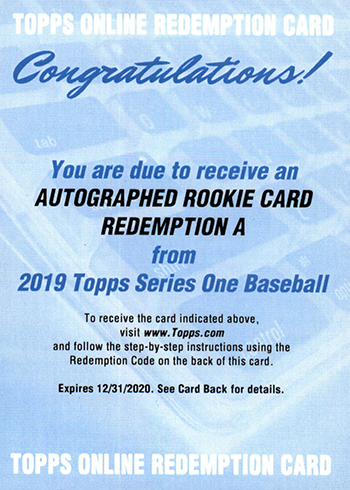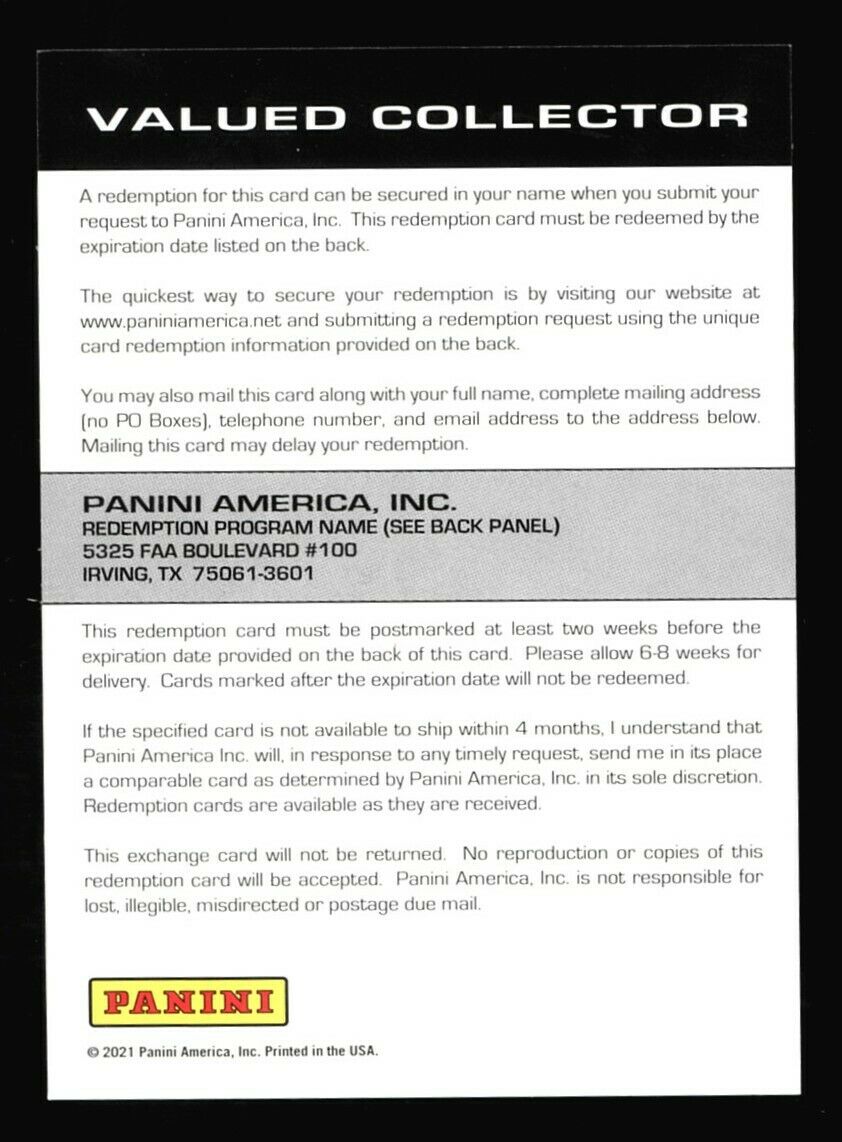The concept of the redemption card is a nice one — but it could use some improvement. Let’s identify three ways to enhance the experience for collectors.
Imagine opening a pack of cards. You’re going through each card meticulously, hoping you’ll receive an autograph of your favorite player. You finally get a card that’s different — your heart flutters accordingly — but ultimately is made of similar card stock as all the rest. This is what’s known in the hobby as a redemption card, and it says you’re due an autograph of LaMelo Ball, Stephen Curry, Justin Fields, Shohei Ohtani, or a similarly sought-after player. Just not right away.
Sure, you have to wait, but you’re filled with excitement over the fact that this redemption card effectively guarantees an autograph of the player you’ve been chasing.


Unfortunately, some redemptions can take over a decade to fulfill.
Yes, for the most part, redemptions pretty much stink. That means we need to talk about what trading card manufacturers can do to make them more appealing to consumers.
Redemptions have been a part of the hobby for as long we can remember. Brands such as Topps and Panini offer them in order to stick to tight release schedules and avoid delaying a product because one or two players haven’t signed their required allotment yet. Ultimately, the hobbyist suffers the pain of knowing or not knowing if the redemption will ever be fulfilled.
With that in mind, Boardroom took a look at different approaches brands like Panini, Topps, Leaf, and Fanatics can take to take the redemption process and… well, redeem it.
Produce Fewer Autographs
The 2021 Panini Prizm Football set has over 20 different color variations, with numbered mints as low as 1-of-1 to as high as /249 — and that doesn’t even include Silver or Base variations. Autographs tend to be available in almost every color variation, so for any one particular set, an athlete could be required to crank out literally thousands of signatures.
Imagine being an athlete, training all day, and then coming home to thousands of cards or stickers to be signed for one trading card set. That’s the equivalent of 100 episodes’ worth of Bart’s chalkboard writing in the opening credits of The Simpsons.
There are several benefits to lowering the overall number of autographs per set. Not only are players more inclined to sign the cards that are allotted, but it makes the autographs more valuable in the long run. If brands are going to continue increasing the number of autographs, they’re going to have to pay more cash. Additionally, going this route would reduce the chances of a situation like collectors witnessed with Dak Prescott in 2017, who was determined to have used an autopen to sign autographs, forcing a recall of his signed 2016 Panini Prizm autos.
Pay the Players More
Speaking of scarcity, unless Panini or Topps have a separate, exclusive deal in place, athletes are only getting paid an unwavering set amount to sign thousands of autographs that was established during endorsement negotiations between the athlete’s respective league and the card manufacturer in question. If that athlete becomes one of the better players in their league, they should be able to negotiate for a bigger cut of the proceeds given that their autographs will be more sought-after. Especially with the boom of interest in the trading card hobby over the past two to three years, the athletes deserve a fairer stake in that success.
Enhance the Redemption Experience
Waiting to receive a redemption can be one of the most unpleasant experiences in the hobby. What’s even worse? Trying to get a response from an outfit like Panini or Topps when it comes to replacing a redemption. Here and now on the Panini App, you’re able to elect for a replacement for an unredeemed redemption, but even after making that choice, you’re likely to wait for an extended period of time just to get a response
Brands can and should do better to enhance this experience. If replacements are going to be offered, they need to function as a solution for collectors whose patience will inevitably wear thin — not simply a new reason to wait.
First, brands can make redemption cards more appealing to the consumer. Topps does a good job of indicating whether you’re in store for a variation or a /99 or something of the sort. A Panini redemption card lists key details in plan text like set, card, player, and occasionally information regarding whether the card is a variation or from a limited, numbered mint. Trading card companies could build more excitement, however, by printing a picture (or at least a mockup) of the actual card on the back — the things themselves are already made; they just don’t have the autograph sticker or on-card signature yet. It’s a low-effort adjustment that enhances the experience for the collector.
Second, trading card companies can produce an easy-to-access redemption database. Much like tracking the shipment of a package, this database would show where a particular card currently is within the redemption process all the way from request to fulfillment. That way, a hobbyist can know if the card is already signed, due to be signed, or fully ready and on the way. Also, this process provides additional transparency as to which redemptions are still yet to be hit in sealed wax, driving additional interest to those products.
Finally, these manufacturers can find better, more efficient ways to communicate with their customers about delays and whether or not players are actually signing their card allotments. Recently, Leaf noted on social media that they were taking a player to court over unfulfilled redemptions. That player later ended up fulfilling them, so the desired result was achieved, but it’s still highly unusual to see a company go to such lengths to ensure it can deliver what it’s promised to consumers.
All told, as we progress into the future, there is quite a lot a trading card manufacturer can do to make the redemption process a more enjoyable, rewarding experience. Even with all the amount of new capital that’s flowing into the industry from big-time investors, these companies cannot forget who makes up the backbone of the trading card hobby — the collectors.
A hobbyist’s experience with a redemption card doesn’t have to be a negative one. Fortunately, the brands that make this industry go have significant power to change the game for the better.